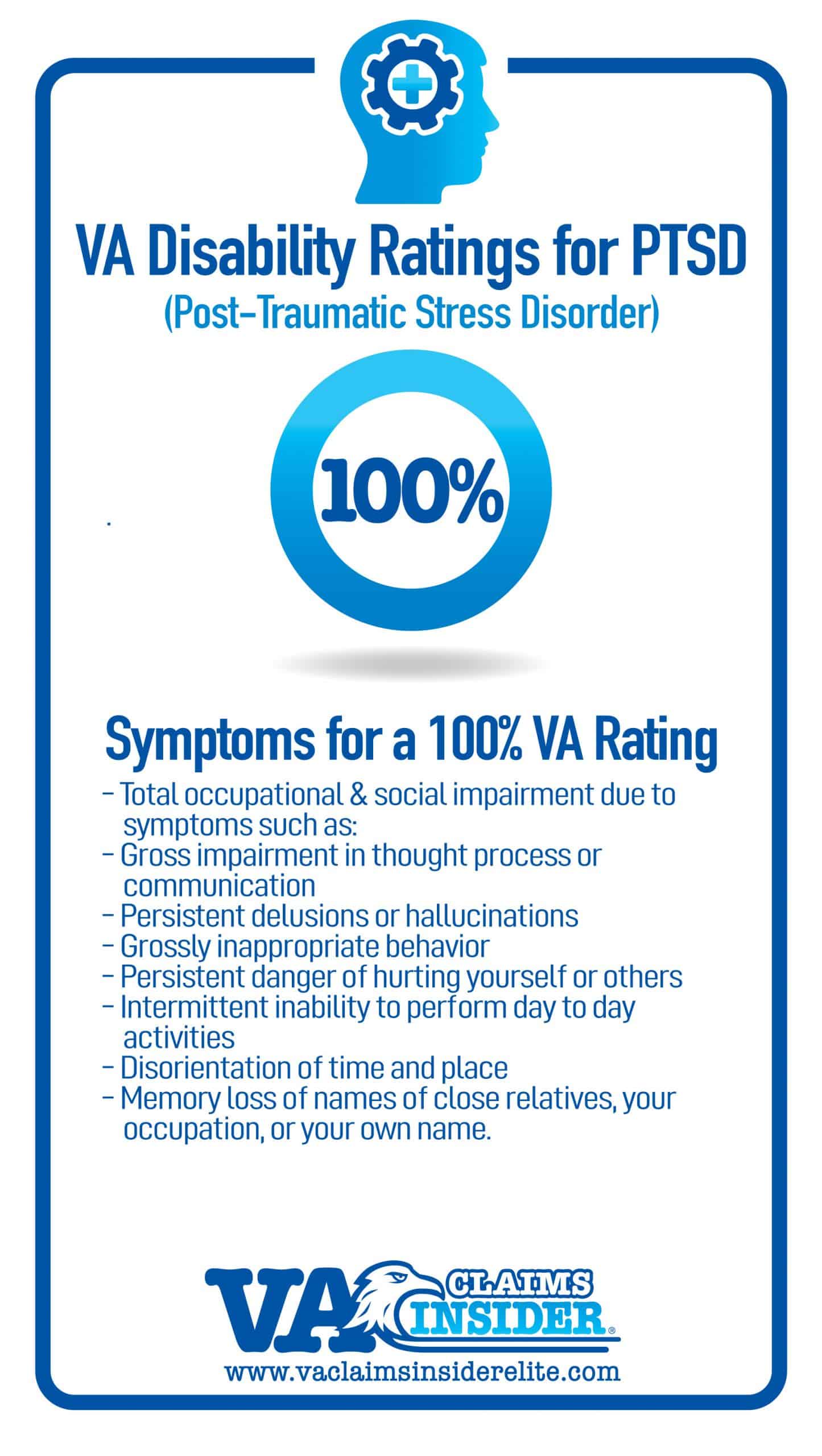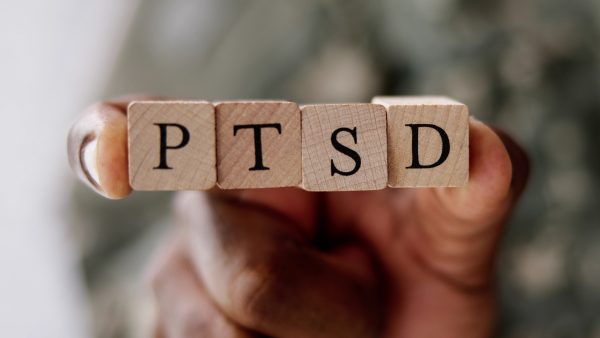Looking for Expert-Level VA Claim Answers?📱Call Us Now! 737-295-2226
A lot of veterans suffering from service connected PTSD want to know how to get 100 VA disability from the VA for PTSD.
According to VA statistics, 13.1% of all veterans receiving disability compensation for mental health have a 100 percent rating for PTSD.
The 100 PTSD rating has the most serious symptoms of occupational and social impairment, according to 38 CFR PTSD.
VA disability for PTSD is rated from 0 percent to 100 percent, with breaks at 10 percent, 30 percent, 50 percent, and 70 percent.
Can I work with a 100 PTSD rating?
Yes! You can still work with a 100 percent scheduler PTSD rating.
Veterans with a 100 VA disability from the VA for PTSD also qualify for Special Monthly Compensation.
What is the PTSD rating scale?
You might be interested in the PTSD rating scale, which can be found HERE:
30 VA Rating for PTSD: 30 VA disability rating for PTSD? Click HERE to read now.
50 VA Rating for PTSD: automatic 50 VA disability rating for PTSD? Click HERE to read now.
70 VA Rating for PTSD: 70 VA disability rating for PTSD? Click HERE to read now.
100 VA Rating for PTSD: 100 VA disability from the VA for PTSD? Click HERE to read now.
Is PTSD easy to claim for VA disability?
According to the top 3 easiest VA claims to win data, PTSD is an easy thing to claim for VA disability.
The VA’s own internal data reported to congress, describes veterans as having the following ratings for PTSD:
- 2.2% of all VA disability recipients for PTSD have a 0 PTSD rating.
- 7.1% of all VA disability compensation claim recipients for PTSD have a 10 PTSD rating.
- 23.7% of all VA compensation claim recipients for PTSD have a 30 PTSD rating.
- 25.9% of all VA disability recipients for PTSD have a 50 PTSD rating.
- 28.0% of all VA claim recipients for PTSD have a 70 PTSD rating.
- 13.1% of all VA disability claim recipients have a 100 PTSD rating.
Should I apply for PTSD claim? Click HERE to read now.
VA Rating Scale for PTSD
0 PTSD Rating Criteria
A mental condition has been formally diagnosed, but symptoms are not severe enough either to interfere with occupational and social functioning or to require continuous medication.
10 PTSD Rating Criteria
Occupational and social impairment due to mild or transient symptoms which decrease work efficiency and ability to perform occupational tasks only during periods of significant stress, or symptoms controlled by continuous medication.
30 PTSD Rating Criteria
Occupational and social impairment with occasional decrease in work efficiency and intermittent periods of inability to perform occupational tasks (although generally functioning satisfactorily, with routine behavior, self-care, and conversation normal), due to such symptoms as: depressed mood, anxiety, suspiciousness, panic attacks (weekly or less often), chronic sleep impairment, mild memory loss (such as forgetting names, directions, recent events).
50 PTSD Rating Criteria
Occupational and social impairment with reduced reliability and productivity due to such symptoms as: flattened affect; circumstantial, circumlocutory, or stereotyped speech; panic attacks more than once a week; difficulty in understanding complex commands; impairment of short- and long-term memory (e.g., retention of only highly learned material, forgetting to complete tasks); impaired judgment; impaired abstract thinking; disturbances of motivation and mood; difficulty in establishing and maintaining effective work and social relationships.
70 PTSD Rating Criteria
Occupational and social impairment, with deficiencies in most areas, such as work, school, family relations, judgment, thinking, or mood, due to such symptoms as: suicidal ideation; obsessional rituals which interfere with routine activities; speech intermittently illogical, obscure, or irrelevant; near-continuous panic or depression affecting the ability to function independently, appropriately and effectively; impaired impulse control (such as unprovoked irritability with periods of violence); spatial disorientation; neglect of personal appearance and hygiene; difficulty in adapting to stressful circumstances (including work or a worklike setting); inability to establish and maintain effective relationships.
How to get 100 VA disability from the VA for PTSD – Total Occupational and Social Impairment

Total occupational and social impairment, due to such symptoms as: gross impairment in thought processes or communication; persistent delusions or hallucinations; grossly inappropriate behavior; persistent danger of hurting self or others; intermittent inability to perform activities of daily living (including maintenance of minimal personal hygiene); disorientation to time or place; memory loss for names of close relatives, own occupation, or own name.
A common misconception from the veteran community is that you need to meet ALL the subjective symptoms tied with a certain PTSD rating in order to get that rating.
This is not true!
The Rating Veteran Service Representative, also known as the RVSR, will consider all the evidence of record, and normally will assign the VA rating for PTSD that includes the “preponderance of the symptoms.”
For example, if a veteran has 4 of the symptoms from the 70 rating for PTSD criteria and 6 of the symptoms from the 100 PTSD VA rating criteria, the RVSR shall assign the higher rating, unless evidence of record contradicts this subjective assessment.
However, the opposite is also true.
For example, if a veteran has 6 of the symptoms from the 70 rating for PTSD criteria and 4 of the symptoms from the 100 PTSD VA rating criteria, the RVSR shall assign the lower rating, unless evidence of record contradicts this subjective assessment.
How the VA Decides Your PTSD Rating
According to 38 CFR PTSD §4.126, evaluation of disability from mental disorders, the RVSR is required to consider these two rules:
1. When evaluating PTSD, the rating agency shall consider the frequency, severity, and duration of psychiatric symptoms, the length of remissions, and the veteran’s capacity for adjustment during periods of remission.
The rating agency shall assign an evaluation based on all the evidence of record that bears on occupational and social impairment rather than solely on the examiner’s assessment of the level of disability now of the examination.
2. When evaluating the level of disability for PTSD, the rating agency will consider the extent of social impairment but shall not assign an evaluation solely based on social impairment.
How to File a VA Claim for PTSD
If you’re wondering how to get 100 VA disability from the VA for PTSD or you think you deserve a higher VA rating for PTSD, you should read How to File a Claim for PTSD.
? Join VA Claims Insider Elite, get instant access to the ELITE Experience Portal (EEP) and $7,500 worth of proprietary VA claim resources TODAY, and have our medical team get started on your VA disability claim for FREE:
>> http://www.vaclaimsinsiderelite.com <<
Deserve a HIGHER VA Rating? WE CAN HELP.
Join our premier education-based membership program, VA Claims Insider Elite, connect with an expert-level Veteran Coach (VC) within minutes, and finally get the rating you deserve. Click the button below to get started.
About the Author

Brian Reese
Brian Reese is a world-renowned VA disability benefits expert and the #1 bestselling author of VA Claim Secrets and You Deserve It. Motivated by his own frustration with the VA claim process, Brian founded VA Claims Insider to help disabled veterans secure their VA disability compensation faster, regardless of their past struggles with the VA. Since 2013, he has positively impacted the lives of over 10 million military, veterans, and their families.
A former active-duty Air Force officer, Brian has extensive experience leading diverse teams in challenging international environments, including a combat tour in Afghanistan in 2011 supporting Operation ENDURING FREEDOM.
Brian is a Distinguished Graduate of Management from the United States Air Force Academy and earned his MBA from Oklahoma State University’s Spears School of Business, where he was a National Honor Scholar, ranking in the top 1% of his class.




